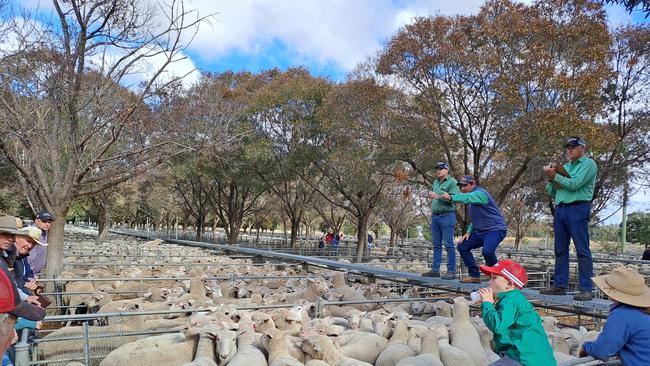Analysis: why the dip in US lamb demand is hitting prices
Easter is seen as one of the peak times to sell Australian lamb into the US. But new figures show that hasn’t been the case this year.
Processors have been reluctant to offer forward price deals for lamb this year and it can be partly explained by new data from the US that suggests trade has been difficult into Australia’s largest export market.
Both the price and volume of lamb, mutton and goat meat (the data is all combined) shipped into the US from all world suppliers during February were lower, according to the US Department of Agriculture, which released the statistics last week.
The official figures were lamb-mutton-goat imports of 9488 metric tonnes, down 12 per cent on a year ago, while the value of all this product dropped 18 per cent, or the equivalent of $US14 million less at a cost of $US78.9 million.
Australia and New Zealand supply the bulk of the product – at 77 per cent and 20 per cent respectively – and even though goat is lumped into the data it only represents a minuscule amount, with lamb and mutton dominating.
The breakdown for Australia and New Zealand for the month of February was:
AUSTRALIA sold 7.3 million tonnes of product to the US, down 9 per cent on a year ago, while the value slipped 11 per cent, down to $56.3 million.
NEW ZEALAND sold 2003 metric tonnes, down 15 per cent, with the value dropping 30 per cent.
Also out last week was the latest analysis of the US lamb market from Steiner Consulting, regarded as one of the leading market commentators in that country.
Based on US mandatory price reporting data, Steiner said lamb remained under pressure as it fought for consumer support against cheaper proteins such as chicken and pork in a challenging economy.
The latest price breakdown Steiner published for Australian and New Zealand lamb imported into the US showed:
CHILLED product (including racks, legs, boneless shoulders, tenderloins) was listed at an average of $US5.47/pound, compared to $7.05 a year ago for a decline of 22.5 per cent;
FROZEN product was listed at $UA6.74/pound, down 9 per cent from last February when it was $US7.43.
Lamb buyers have told The Weekly Times one of the reasons processors won’t commit to forward pricing for lamb is that overseas markets such as the US were struggling to gain traction and the money farmers would want to grain-feed lamb for the winter didn’t stack-up against current export returns.
“The message we are trying to put out there by not offering contacts is we can’t pay 800c/kg for lambs,’’ said one buyer prior to Easter.

It makes for an interesting dynamic, as the lack of commitment and price direction from processors means many farmers have shied away from feeding stock this year, which has resulted in fewer well finished lambs being available in saleyards.
The auction price trend for lamb heading into Easter was stronger, with prices for heavy slaughter lambs (26-30kg carcass weight) moving up to an average of 720c/kg carcass weight to be just 10c/kg shy of a year ago.
The saleyard price for heavy lambs briefly peaked at 802c/kg carcass weight in the first week of June last winter, before dramatically dropping away. Just eight weeks later in the first week of August it hit a low of 650c/kg carcass weight, according to historical data from the National Livestock Reporting Service.
In the short-term, the recent rain should help support the market as farmers regain some confidence that the season may not be an El Nino wipe-out. Market sentiment for both cattle and sheep has improved in the past 10 days.
But the demand side of the lamb market does appear fragile.
To refer back to the US market, among all the fresh data put out by the USDA last week was an update on the amount of lamb and mutton in frozen storage across America.
Inventories have spiked, with the amount of frozen product now estimated at 28.6 million pounds in cold storage at the end of February, which is nearly 29 per cent higher than year-ago levels.
Steiner noted a 13 per cent month-on-month increase in meat stored had gone against the historical average of just a 1 per cent gain usually seen between January and February.
Part of it is due to the ongoing liquidation of the US sheep flock. Despite much of the country coming out of severe drought, the US lamb kill has remained elevated.
There were 154,800 lambs processed the US during February, up 8 per cent on a year ago. And the higher kills have continued, Steiner said, due to American producers struggling to remain viable due to lower lamb prices.
“Producer margins have been extremely stressed in the past six months and the improvement in weather conditions may do little to encourage them to expand,’’ Steiner noted in its latest analysis.
In what could be viewed as a positive for Australian sheep farmers, the US flock appears to be declining at a more rapid rate.
The National Agricultural Statistics Service (or NASS as it is known in the US) believes the breeding ewe flock across America has dropped by another 1.2 per cent down to 3.665 million.
It stated: “The decline in the breeding flock was slightly above historical trends, which have typically been just below a 1 per cent decline.
“Looking further into the breeding flock, the inventory of ewes one year and older as of January 1 this year was at 2.870 million, down 1.4 per cent or 40,000.’’




